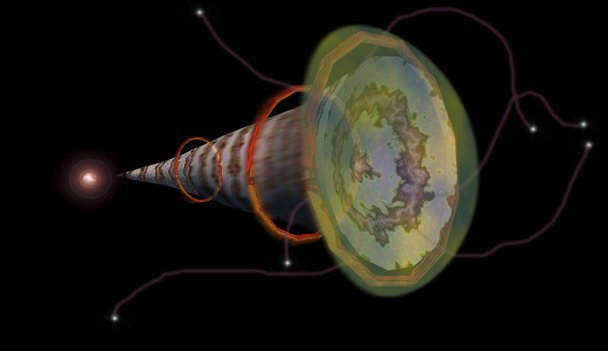Explanation: Cosmic Rays are celestial high energy particles traveling at nearly the speed of light, which constantly bombard the Earth. Discovered during high altitude balloon flights in 1912 their source has been a long standing mystery. But a recent theory suggests that cosmic ray particles are atomic nuclei blasted from dust grains formed in supernovae, the death explosions of massive stars. This artist's illustration shows a supernova explosion (at left) and a conical section of the expanding cloud of ejected material. Atoms are torn from the brownish bands of "dust" material by shock waves (represented by orange rings). The shocks in the expanding blast wave then accelerate the atoms to near light speeds firing them into interstellar space like cosmic bullets. The theory is supported by observations indicating that high velocity dust was formed in the nearby supernova 1987A, and that Beryllium, a light element created in Cosmic Ray collisions, is found equally in both old an young stars. NASA's Advanced Composition Explorer (ACE) satellite can also test details of the theory by directly measuring Cosmic Rays.
1999 2000 2001 2002 2003 2004 2005 2006 2007 2008 2009 2010 2011 2012 2013 2014 2015 2016 2017 2018 2019 2020 2021 2022 2023 2024 2025 |
Yanvar' Fevral' Mart Aprel' Mai Iyun' Iyul' Avgust Sentyabr' Oktyabr' Noyabr' Dekabr' |
NASA Web Site Statements, Warnings, and Disclaimers
NASA Official: Jay Norris. Specific rights apply.
A service of: LHEA at NASA / GSFC
& Michigan Tech. U.
|
Publikacii s klyuchevymi slovami:
dust - cosmic rays - supernova - Sverhnovye - udarnye volny - kosmicheskie luchi
Publikacii so slovami: dust - cosmic rays - supernova - Sverhnovye - udarnye volny - kosmicheskie luchi | |
Sm. takzhe:
Vse publikacii na tu zhe temu >> | |
